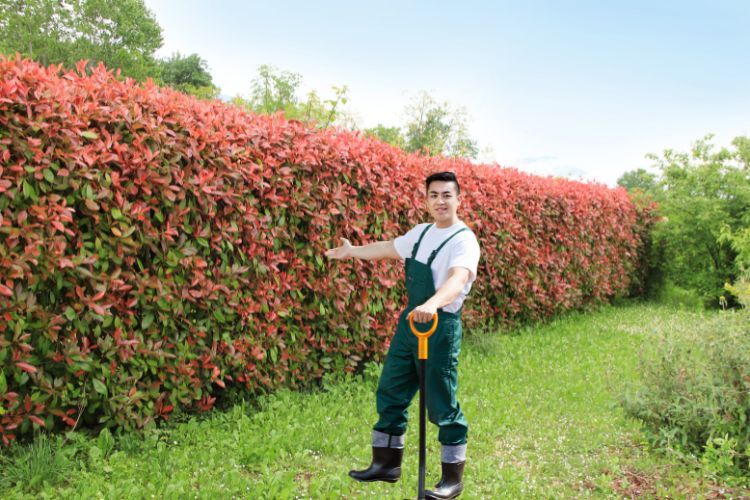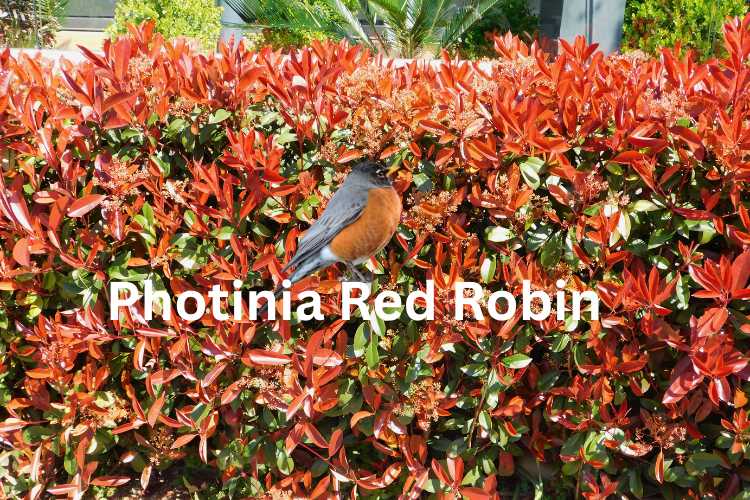Photinia Red Robin Hedging Trees
24th Apr 2025
Imagine a beautiful summer morning as you step into your garden to be greeted each morning, greeted by a wall of glossy bronze–red foliage. But it isn't just summer; Photinia Red Robin glows in every season. Its all-year round foliage and colour is why the plant has now become a firm favourite with gardeners. It's easy to see why.
Photinia Red Robin hedging trees are colourful, vibrant, and hardy. Furthermore, Red Robin is so versatile and can be used as a traditional hedge or as standalone plants which is why it stands out against more traditional hedges like Leylandii.
Meet Photinia Red Robin
Botanical Background
Photinia Red Robin is a hybrid between Photinia glabra and Photinia serrulata, and was first introduced in the 1960s. Over the decades, it’s won gardeners’ hearts for its hardiness and eye-catching leaf colour.
Key Traits
- Foliage: The plant's most attractive trait. Every spring, new bronze-red shoots emerge before maturing to a glossy green. This cycle repeats throughout the growing season and provides continual bursts of colour.
- Evergreen: Even in winter, the plant keeps most of its foliage. If you're using Red Robin as a hedge, it provides privacy all year round.
- Growth Rate: Photinia Red Robin hedging trees aren't the fastest growing plants. They have a moderate growth of around 30–40 cm per year. When established it reaches between 2–4 metres in both height and spread. This makes Red Robin ideal for a substantial hedge without being too overwhelming for small gardens.
Photinia vs. Leylandii: How They Compare
Leylandii is probably the most common hedging plant in the UK. This isn't surprising when you consider that when you’re choosing a hedge, growth rate is often the deciding factor. Leylandii is famous (or notorious) for its rapid pace, often shooting up by 60–90 cm a year. In contrast, Photinia Red Robin grows at a more modest 30–40 cm annually. However, that moderate growth rate means you spend less time wielding the hedge trimmer at your Red Robin hedge and more time enjoying your greenery.
Colour is another major difference. Leylandii offers a uniform, deep-green screen all year round, which is functional but can feel a little monotonous. Photinia Red Robin, by comparison, delivers twice the visual interest: each spring and summer, new bronze-red leaves bloom before maturing too glossy green. This seasonal contrast is something a solid green conifer simply can’t match.
When it comes to maintenance there is a bit of a difference between the two types of hedging. Leylandii needs frequent clipping to keep its explosive growth in check. Neglecting this can result in towering hedges that are tricky (and expensive) to get back into shape. By contrast Photinia Red Robin requires only a couple of light trims a year. Usually after the spring flush of new growth and again in late summer. This makes Red Robin a little easier to manage for most gardeners.

From an ecological viewpoint there's only one winner. Red Robin’s Spring flowers attract insects, and the red berries are a welcome food source for birds. On the other hand, Leylandii, while providing a dense screen, offers limited forage and habitat value.
Resistance to disease is worth considering too. Leylandii can suffer from cypress canker and other fungal issues. Photinia Red Robin is generally more robust, with the occasional leaf spot being the most common ailment.
Visually, it's a matter of taste I suppose. But it's hard to argue that Photinia Red Robin does have more seasonal interest. Rather than an unchanging green backdrop, you get vibrant new growth in striking red, glossy foliage for most of the year. Red Robin is a hedge that changes with the seasons. It adds texture, colour, and life to your garden in a way that Leylandii can’t quite match.
Ten Reasons to Choose Photinia Red Robin
- 1: Seasonal Colour Every spring and summer, fresh bronze shoots mature to rich green—creating a two-tone effect that looks amazing in your garden.
- 2: Manageable Growth Rate With a steady 30–40 cm of growth per year, Red Robin is much easier to control than faster-growing hedging plants like conifers, so you spend less time pruning and more pottering around your garden.
- 3: Wildlife Magnet Your Red Robin hedging trees will attract insects and birds will enjoy feeding on the berries in autumn and winter.
- 4: Fully Hardy Red Robin normally resists most serious diseases though you may see occasional leaf spot.
- 5: So Versatile You can use Photinia Red Robin hedging plants either as a dense privacy screen or standalone small-form trees.
- 6: Year-Round Interest Being semi-evergreen, it retains most of its foliage in winter providing colour even when many other plants lie dormant.
- 7: Soil Friendly Red Robin can thrive in just about any kind of soil from light, sandy soils to heavier clay. But, like any plant, if your garden’s drainage isn’t perfect—just avoid waterlogged spots.
- 8: Drought Tolerance In truth not something we often have to think about in the UK but once established, its deep root system copes well with drier spells.
- 9: Low Maintenance Apart from two light trims a year, it only requires minimal feeding. Happy days for most of us.
- 10: Design Flexibility You can use it in mixed hedges, underplanted borders, or even in containers.

Quick Guide to Planting & Care
You don’t need a degree in horticulture to get started—just follow these simple steps:
Site & Spacing
Plant in a spot that enjoys full sun or partial shade, in well-draining soil. If you want a dense hedge space each plant about one metre apart.
Planting
Dig a hole just slightly wider than the root ball and backfill with existing soil. Mix in a handful of well-rotted compost. Water in thoroughly and apply a layer of mulch to help retain moisture.
Basic Maintenance
- Spring Trim: Once new shoots have grown about 10 cm, give your hedge a light trim to encourage branching.
- Late Summer Prune: A second light trim keeps the hedge neat—avoid cutting back into old wood, and never remove more than one-third of new growth at once.
Design Inspiration
Mixed-Hedge Schemes
Combine Red Robin with other evergreens like English yew or flowering shrubs to make an attractive contrast.
Standalone Small Trees
Use a single Red Robin as a focal point. It could flank a driveway or mark an entrance. Train it into a standard (tree form) by removing lower branches.
Underplanting
Plant shade-tolerant perennials like Hosta or Heuchera at the base of your hedge. Their lighter foliage will balance the warm reds of the Red Robin.
Plant in Containers
Smaller or young Red Robin trees work beautifully in large tubs on patios or terraces. This lets you enjoy its vibrant colour at eye level and of course you can move containers to protect them in the winter.
Used as a hedge Photinia Red Robin will provide all the privacy you need with none of the headaches of fast-growing conifers. But you can also use it as a standalone small tree. So, you have plenty of options if you want to add it to your outdoor space.
Ready to transform your garden? Explore quality Red Robin hedging plants from Direct Hedging Plants and transform your garden.


